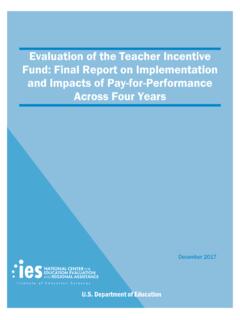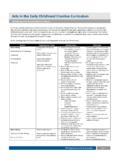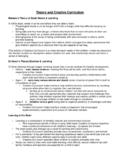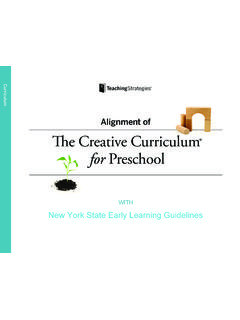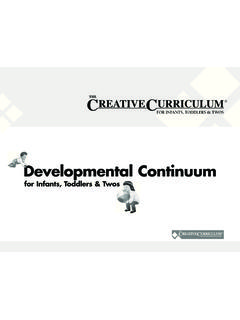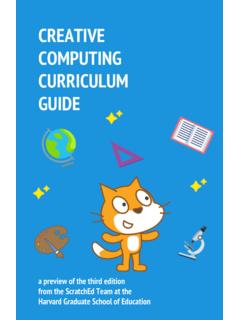Transcription of WWC Intervention Report U.S. DEPAR TMENT O EDCATION …
1 The creative curriculum for Preschool, Fourth Edition Updated March 2013 Page 1 WWC Intervention Report DEPARTMENT OF EDUCATIONWhat Works clearinghouse Early Childhood Education Updated March 2013 The creative curriculum for Preschool, Fourth EditionProgram Description1 The creative curriculum for Preschool, Fourth Edition, is an early childhood curriculum that focuses on project-based investigations as a means for children to apply skills and addresses four areas of development: social/emotional, physical, cognitive, and language. The curriculum is designed to foster development of the whole child through teacher-led, small and large group activities centered around 11 interest areas (blocks, dramatic play, toys and games, art, library, discovery, sand and water, music and movement, cooking, comput-ers, and outdoors). The curriculum provides teachers with details on child development, classroom organization, teaching strategies, and engaging families in the learning process.
2 Child assessments are an important part of the curriculum , but must be purchased separately. Online record-keeping tools assist teachers with the maintenance and organization of child portfolios, individualized planning, and Report production. Research2 The what Works clearinghouse (WWC) identified two studies of The creative curriculum for Preschool, Fourth Edition, that both fall within the scope of the Early Childhood Education topic area and meet WWC evidence One study meets standards without reservations and one study meets WWC evidence standards with reservations, and together, they included 364 children in 11 full-day preschools located in Georgia, North Carolina, and Tennessee. The WWC considers the extent of evidence for The creative curriculum for Preschool, Fourth Edition, on the school readiness of preschool children to be medium to large for four outcome domains oral language, print knowledge, phonological processing, and math.
3 There were no studies that meet standards in two other domains, so we do not Report on the effectiveness of The creative curriculum for Preschool for those domains in this inter-vention Report . (See the Effectiveness Summary on p. 6 for further description of all domains.)EffectivenessThe creative curriculum for Preschool, Fourth Edition, was found to have no discernible effects on oral language, print knowledge, phonological processing, or math for preschool ContentsOverview p. 1 Program Information p. 3 Research Summary p. 4 Effectiveness Summary p. 6 References p. 9 Research Details for Each Study p. 11 Outcome Measures for Each Domain p. 16 Findings Included in the Rating for Each Outcome Domain p. 17 Supplemental Findings for Each Outcome Domain p. 21 Endnotes p. 23 Rating Criteria p. 24 Glossary of Terms p. 25 The creative curriculum for Preschool, Fourth Edition Updated March 2013 Page 2 WWC Intervention ReportTable 1.
4 Summary of findings4 Improvement index (percentile points)Outcome domainRating of effectivenessAverageRangeNumber of studiesNumber of childrenExtent of evidenceOral languageNo discernible effects+2 6 to +92362 Medium to largePrint knowledgeNo discernible effects 2 7 to +82363 Medium to largePhonological processingNo discernible effects 2 4 to +12364 Medium to largeMathNo discernible effects+2 5 to +82363 Medium to largeThe creative curriculum for Preschool, Fourth Edition Updated March 2013 Page 3 3 WWC Intervention ReportProgram InformationBackgroundDeveloped by Diane Trister Dodge, Laura Colker, and Cate Heroman, The creative curriculum for Preschool, Fourth Edition, is distributed by Teaching Strategies, Inc. Address: 7101 Wisconsin Ave., Suite 700, Bethesda, MD 20814. Email: Web: Telephone: (800) 637-3652. The studies reviewed by the WWC are all evaluations of the Fourth Edition of The creative curriculum for Preschool.
5 In July 2011, the developer released The creative curriculum for Preschool, Fifth Edition, as part of The creative curriculum System for Preschool. No effectiveness studies of this updated, expanded curriculum have been completed. Therefore, this Intervention Report focuses on the Fourth detailsThe creative curriculum for Preschool, Fourth Edition, is an early childhood curriculum designed to foster social/emotional, physical, cognitive, and language development and to enhance learning in literacy, math, science, social studies, the arts, and technology. The program includes information on children s development and learning, classroom organization and structure, teaching strategies, instructional goals and objectives, and guidance on how to engage families in their children s learning. The creative curriculum for Preschool provides direction for inten-tional, teacher-guided learning experiences in large and small group settings.
6 The program is centered around the following 11 interest areas: blocks, dramatic play, toys and games, art, library, discovery, sand and water, music and movement, cooking, computers, and outdoors. The curriculum describes the learning that occurs through play in each area, the ways in which children might engage with the materials in each area, and teacher interactions to promote and scaffold children s learning. The curriculum includes the use of project-based investigations, called studies, that are focused on meaningful science and social studies topics and that aim to provide children with an opportunity to apply skills in literacy, math, the arts, and technology. Sug-gestions on how to adapt these activities for children with disabilities and English language learners are provided for each component of the curriculum . The creative curriculum for Preschool also emphasizes the use of observation-based child assessments to help guide instruction.
7 In addition to the general curriculum guide, separate literacy, math, science, and social studies guides are available. Implementation, evaluation guidance, and professional development services are also avail-able from the developer, both online and The creative curriculum for Preschool, Fourth Edition, is no longer available for purchase from the distributor. The creative curriculum : The Foundation, a teacher s guide to The creative curriculum for Preschool, Fifth Edition, can be purchased for $ This guide provides the theory and research foundation of the curriculum and helps teachers decide how to set up their classrooms. Teaching Strategies, Inc., also offers The creative curriculum System for Preschool, which provides all the resources necessary to implement the program in a classroom. The system costs $2, and includes the following curriculum materials: The creative curriculum : The Foundation, The Guide to The creative curriculum System for Preschool, Getting Started DVD, 100 Mighty MinutesTM activity cards, 201 Bilingual Intentional Teaching CardsTM, six teaching guides, 22 book discussion cards, The Teaching Strategies Children s Book Collection featuring 75 books, The Resource Organizer, and The Classroom and Family Resources implementation and evaluation guidance, as well as professional development services, can be pur-chased from the developer and delivered either onsite or online.
8 The creative curriculum for Preschool, Fourth Edition Updated March 2013 Page 4 WWC Intervention ReportResearch SummaryThe WWC identified 14 studies that investigated the effects of The creative curriculum for Preschool, Fourth Edition, on the school readiness of preschool children. The WWC reviewed four of those studies against group design evidence standards. One study (PCER Consortium, 2008, Chapter 3) is a randomized controlled trial that meets WWC evidence standards without reservations and one study (PCER Consortium, 2008, Chapter 2) is a randomized controlled trial that meets WWC evidence standards with reservations. Those two studies are summarized in this Report . Two stud-ies do not meet WWC evidence standards. The remaining ten studies do not meet WWC eligibility screens for review in this topic area. Citations for all 14 studies are in the References section, which begins on p.
9 9. Table 2. Scope of reviewed researchGradePKDelivery methodWhole classProgram typeCurriculumSummary of study meeting WWC evidence standards without reservationsThe PCER Consortium (2008) study (Chapter 3) assessed the effects of The creative curriculum for Preschool using a randomized controlled trial of teachers and children in five Head Start centers in Georgia and North In the pilot year of the study (the 2002 03 school year), 20 teachers were grouped by education and teacher certification status and then randomly assigned within each group to either the Intervention group or the compari-son group. Eighteen of the classrooms that were randomly assigned in the pilot year continued to participate during the national PCER evaluation year (the 2003 04 school year), and 194 children were selected for the study. Children within a Head Start center were sorted into groups on the basis of gender, disability status, and ethnicity, and within groups, they were randomly assigned to either Intervention or comparison classrooms.
10 Each of the five participat-ing Head Start centers included both Intervention and comparison classrooms. The authors investigated effects on oral language, print knowledge, phonological processing, and math. The WWC based its effectiveness ratings on findings from comparisons of 90 children who received The creative Curricu-lum for Preschool and 81 comparison group children. The comparison condition was not a particular curriculum ; rather, it consisted of teacher-developed curricula with a focus on basic school readiness. The authors reported on the effects of The creative curriculum for Preschool in the spring of the preschool year and again at the end of kindergarten. The outcomes reported at the end of the kindergarten year are not included in the WWC s effective-ness calculations but are presented as supplemental findings in Appendix D. The authors also reported findings on the Social Skills Rating Scale; however, these findings are not reported here because the current Early Childhood Education topic area protocol does not include sociobehavioral of study meeting WWC evidence standards with reservationsThe PCER Consortium (2008) study (Chapter 2) assessed the effects of The creative curriculum for Preschool using a randomized controlled trial of classrooms in 28 preschools in Tennessee.



